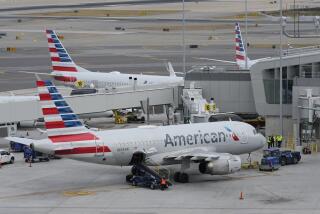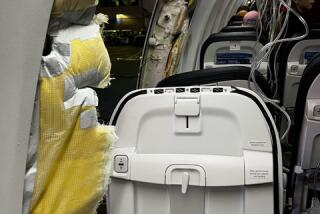American Airlines parent firm files for bankruptcy
Facing staggering labor costs, rising fuel prices and an uncertain economy, the parent company of American Airlines filed for bankruptcy protection and moved to reorganize the struggling operation.
Even as Fort Worth-based AMR Corp.’s bankruptcy filing Tuesday left its 88,000 employees worried about their salaries and pensions, American sought to reassure passengers that it would not affect regular operations.
American, the largest carrier at Los Angeles International Airport, said all tickets, reservations and frequent-flier reward points would be honored.
“American Airlines remains open for business,” said Craig Kreeger, the airline’s vice president for customer experience. “It’s business as usual.”
Until it filed for Chapter 11 protection in New York, AMR represented the last major network carrier in the U.S. to avoid bankruptcy in the tumultuous decade since the Sept. 11, 2001, terrorist attacks that included two American jets — one flown into the World Trade Center and another into the Pentagon.
The AMR board of directors also announced that it had promoted Thomas W. Horton, 50, to be chairman and chief executive officer of the company, to replace Gerard Arpey, who informed the board of his plans to retire. Arpey, 53, had been chief executive officer since 2003 and chairman since 2004.
Arpey chose to resign because “he believes it’s in the best interest of the company for a change of leadership,” Kreeger said.
As of Sept. 30, AMR reported assets of $24.9 billion and liabilities of $29.5 billion, according to its bankruptcy filing. Still, the company said it had about $4.1 billion in cash and short-term investments that could be used to pay vendors and suppliers.
AMR shares plunged more than 80% in trading Tuesday to close at 26 cents a share, down from $1.26 on Monday.
At LAX, passengers said they weren’t worried because other airlines had filed for bankruptcy in the past, and flights, reservations and frequent-flier miles weren’t affected. American’s AAdvantage is the oldest and one of the nation’s largest airline frequent-flier loyalty programs. But there were concerns.
Waiting for his luggage, Lupe Delacruz, an American frequent flier from Dallas who had flown nearly 1 million miles on the airline, said the company assured him that he would not lose his loyalty points.
But he added: “I’m worried that the quality of service might change. … I made a concerted effort to fly with one airline, this airline.”
Several American flight attendants and a pilot, all of whom asked not to be identified for fear of losing their jobs, said they were worried that the bankruptcy filing could lead to staff cuts, but most were not surprised by the news.
“I’ve been expecting this for 10 years,” said the pilot based in Los Angeles, who has flown for American for 26 years. “It doesn’t surprise me at all.”
The employees said they were bracing for pay cuts, layoffs and possible changes in their pensions.
“We have no way of knowing what the future holds, but I am nervous,” the pilot said.
Although AMR has reported steep loses over the last year, many of its competitors that renegotiated labor contracts and debts in the bankruptcy process over the last decade have enjoyed strong profit margins more recently.
AMR reported a loss of $162 million in the three months ended Sept. 30, while its top competitor, the parent company for United and Continental airlines, reported a profit of $773 million in the same period.
“American’s competitors are pretty healthy now, and they are not,” said Seth Kaplan, a managing partner at Airline Weekly, a trade publication. “The airlines’ cost structure is the worst of their problems.”
Like other airlines, American has been struggling to overcome fuel prices that have jumped 41% over the last year. But American said it was also saddled with the highest labor costs in the industry and remains the only major airline still funding worker pensions.
Pilots at American Airlines, for example, earned an average of $205,628 in salaries and benefits last year, about 11% higher than the average for pilots of all major network airlines, according to an analysis by the Airline Data Project at the Massachusetts Institute of Technology.
Flight attendants at American Airlines earned $50,510 in salaries and benefits last year, second-highest to Continental Airlines’ flight attendants, who earn $56,085, according to the MIT analysis.
The union that represents American Airlines’ pilots acknowledged that its members earn more than pilots at other airlines. But union representatives say the higher labor costs are not the sole reason for the carrier’s financial woes.
“The company filed for bankruptcy because they failed to execute a viable business plan,” said Howie Schack, a spokesman for the Allied Pilots Assn., which represents 8,500 American Airlines pilots.
Still analysts say they suspect that a stalemate in the five-year negotiations with pilots forced the airline to file for bankruptcy.
“The choice to file while AMR maintained adequate liquidity … indicates that AMR’s board of directors saw no early resolution to the labor talks, in our opinion,” Standard and Poor’s analyst Philip Baggaley said in a report, in which the rating service lowered its rating on AMR to D from CCC+.
Aaron Gellman, a professor at the Northwestern University Transportation Center and at the Kellogg School of Management, agreed.
“Unfortunately, this is what happens when you face the possibility of intransigent unions,” he said.
Schack said the pilots’ union did not know that American was preparing to file for bankruptcy and concedes that the union lost some of its negotiating leverage. But he said “we look forward to fixing this airline and putting forward a viable business plan.”
Gellman and other analysts say other airlines have emerged from bankruptcy, suggesting that the future for American Airlines seems bright.
“It’s unclear what it means for the company” said Bob McAdoo, an airline analyst for Nashville-based Avondale Partners. “The most likely outcome is that it continues to operate as it has and uses this to secure a labor agreement that is more in line with other airlines.”
But Kaplan of Airline Weekly said the airline may be forced to cut costs and perhaps lay off workers in markets, such as Los Angeles, where it faces tough competition from low-cost airlines like Southwest Airlines.
“Los Angeles,” he said, “is a place that is somewhat vulnerable.”







